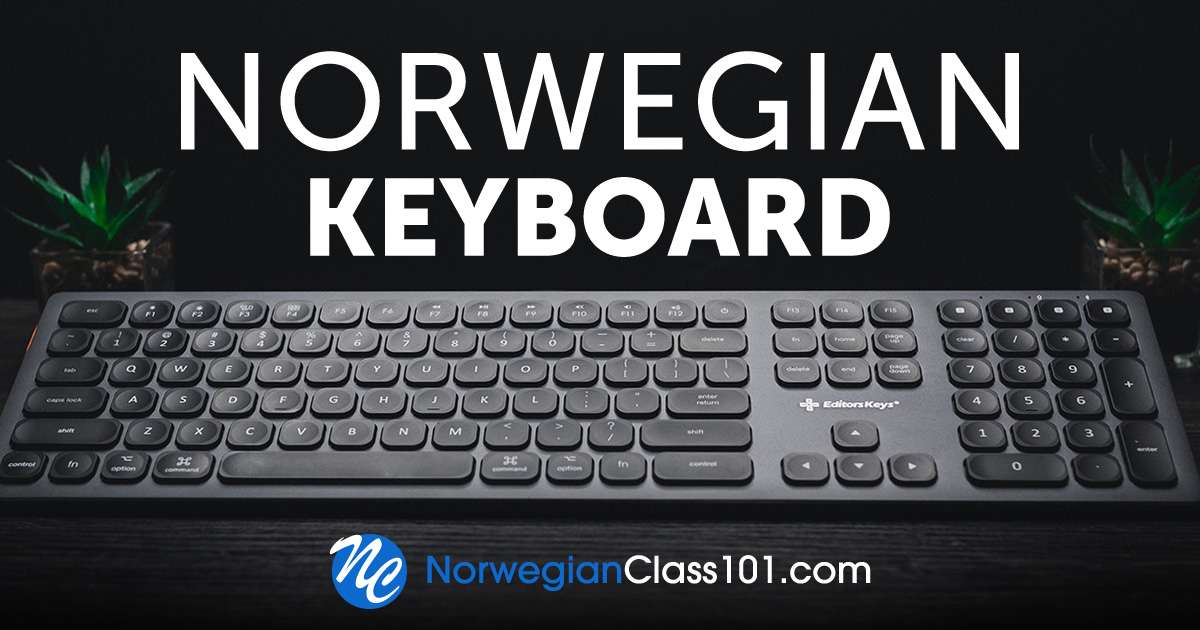Archive for the 'Team NorwegianClass101' Category
October 16, 2020
Norwegian Keyboard: How to Install and Type in Norwegian
You asked, so we provided—easy-to-follow instructions on how to set up your electronic devices to write in Norwegian! We’ll also give you a few excellent tips on how to use this keyboard, as well as some online and app alternatives if you prefer not to set up a Norwegian keyboard.
Table of Contents
Why it’s Important to Learn to Type in Norwegian
Setting up Your Computer and Mobile Devices for Norwegian
How to Activate an Onscreen Keyboard on Your Computer
How to Change the Language Settings to Norwegian on Your Computer
Activating the Norwegian Keyboard on Your Mobile Phone and Tablet
Norwegian Keyboard Typing Tips
How to Practice Typing Norwegian
1. Why it’s Important to Learn to Type in Norwegian
Learning a new... Show more
August 24, 2020
Jeg? Du? De? – Learn Pronouns in Norwegian
Pronouns play a large part in every language, and Norwegian is no exception. Learning the Norwegian pronouns can seem like a daunting task, especially as a beginner. But don’t worry! Pronouns in Norwegian are similar to those in English, and with some practice, you’ll quickly recognize them.
To be understood properly in Norwegian, it’s important to use the right pronouns. Keep in mind that Norwegian has three grammatical genders: male, female, and neutral. Sometimes certain pronouns will change depending on the gender of the object. How they change also depends on where in Norway you are.If you’ve read our article on telling time in Norwegian, you already know, for example, that klokke/klokka, meaning "clock," can be both feminine and... Show more
August 18, 2020
Premium PLUS: The Golden Ticket for Language-Learning
Do you remember the moment you fell in love with languages?
Do you desire to learn or advance in Norwegian quickly and effectively?
Then you need a Norwegian tutor.
A common question that first-time language-learners ask is "Where do I begin?" The answer? Guidance.
For native English-speakers who want to learn Asian languages, for example, timelines provided by the U.S. Foreign Service Institute can appear discouraging. However, defeating these odds is not unheard of. If you want to beat the odds yourself, one of the best learning options is a subscription to Premium PLUS from Innovative Language.
As an active Premium PLUS member of JapanesePod101.com and KoreanClass101.com myself, I have an enjoyable experience learning at an... Show more
July 17, 2020
Essential Vocabulary for Directions in Norwegian
Do you know your left from your right in Norwegian? Asking for directions can mean the difference between a heavenly day on the beach and a horrible day on your feet, hot and bothered and wondering how to even get back to the hotel. Believe me - I know! On my earlier travels, I didn’t even know simple terms like ‘go straight ahead’ or ‘go west,’ and I was always too shy to ask locals for directions. It wasn’t my ego, but rather the language barrier that held me back. I've ended up in some pretty dodgy situations for my lack of directional word skills.
This never needs to happen! When traveling in , you should step out in confidence, ready to work your Norwegian magic and have a full day of exploring. It’s about knowing a few basic... Show more
April 10, 2020
Essential Vocabulary for Life Events in Norwegian
What is the most defining moment you will face this year? From memories that you immortalize in a million photographs, to days you never wish to remember, one thing's for certain: big life events change you. The great poet, Bukowski, said, "We are here to laugh at the odds and live our lives so well, that death will tremble to take us." The older I get, the more I agree with him!
Talking about significant events in our lives is part of every person's journey, regardless of creed or culture. If you're planning to stay in for more than a quick visit, you're sure to need at least a few 'life events' phrases that you can use. After all, many of these are shared experiences, and it's generally expected that we will show up with good manners... Show more
March 30, 2020
Talk About the Weather in Norwegian Like a Native
Did you know that every minute of the day, one billion tons of rain falls on the earth? Hard to believe, considering the climate crisis! Of course, all that rain is not equally shared across the planet.
So, would you mention this fascinating fact to your new acquaintance? Well, small talk about local weather is actually a great conversation-starter. Everyone cares about the weather and you’re sure to hear a few interesting opinions! Seasons can be quite unpredictable these days and nobody knows the peculiarities of a region better than the locals.
NorwegianClass101 will equip you with all the weather vocabulary you need to plan your next adventure. The weather can even be an important discussion that influences your adventure plans.... Show more
February 1, 2019
Secret Revealed: The Best Way to Learn a Language on Your Own
Can You Really Learn Norwegian Alone?
Learning a language on your own or without traditional classroom instruction may seem quite daunting at first. What if you run into questions? How do you stay motivated and on track to achieving goals?
Don’t worry, not only is it possible to learn Norwegian or any language without traditional classroom instruction: NorwegianClass101 has created the world’s most advanced and extensive online language learning system. Not only is NorwegianClass101 specifically designed to help you with learning a language on your own, it’s actually faster, more convenient, and less expensive than traditional classroom options!
Let’s look at some of the benefits of learning Norwegian or any language alone.
Also,... Show more









